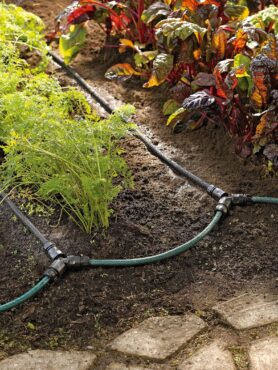
Don’t let your spring garden enthusiasm lead to overplanting and the creation of a summer gardening nightmare. A design with maintenance in mind and some strategic care can help reduce the time you spend managing your gardens and landscape.
Consider using fewer plant species when designing perennial flowerbeds. Increase the number of each to boost the visual impact of the garden and reduce maintenance. You’ll have fewer species to manage, identify and differentiate from the weeds as they emerge in spring.
Select plants that are suited to the growing conditions and don’t require deadheading and staking. Avoid pest- and disease-prone plants, as well as those that quickly multiply and overtake neighboring plants and the garden bed.
Design garden beds with gentle curves and avoid tight spaces that limit access and will make managing the surroundings difficult. Make sure all parts of the garden can easily be reached for planting, weeding, harvesting and care. Add a path of wood chips or a few steppers to large garden beds as needed for easier access.
Reduce watering needs by growing plants suited to your area’s normal rainfall. Group moisture-loving plants together to minimize the amount of water used and time spent watering. Enlist the help of soaker hoses or drip irrigation like the Snip-n-Drip Soaker system when watering is needed. This irrigation system applies water to the soil where needed and can be cut with scissors to fit any garden that is planted in rows.
Reduce watering frequency, suppress weeds and improve the soil with the help of organic mulches like leaves, evergreen needles and wood chips. You’ll gain multiple benefits with this one task. Spread a 1- to 2-inch layer of mulch over the soil surface. Pull it away from tree trunks, shrub stems and off the crowns of flowering plants and vegetables. The finer the mulch material, the thinner the layer of mulch you’ll need.
Slow the infiltration of grass and weeds into garden beds and eliminate the need to hand trim with a bit of edging. Use a shovel to dig a V-shaped trench around the perimeter of the garden edge. Fill this with the same mulch used in your flowerbed to create a mowing strip around the garden bed.
Join forces with neighbors and rent an edging machine for the day or weekend. These machines can make it easier and quicker to accomplish this task. With a shared rental, you all save money and no one has to maintain and store the equipment.
Keep tools handy to save time and energy spent retrieving forgotten tools from the shed or garage. Weatherproof garden tool bags with multiple compartments make it easy to organize, store and carry hand tools, plant tags, gloves and other small items to the garden. Or store them right where they are needed. Convert an old mailbox or invest in a small storage container like the waterproof Galvanized Garden Tool Storage Box from gardeners.com. Mount it on the end of a raised bed, fence or post to keep small tools, gloves, safety glasses and more in a handy location.
Use carts, wagons or a gardener’s summer sled when moving large or heavy loads. You’ll be able to accomplish the move with fewer trips and less muscle strain.
Take time this season to implement a few of these strategies. A few changes can save you time that you can instead spend relaxing, enjoying or adding more gardens.

























